SEO
Over $200K Spent. Here’s What I Learned
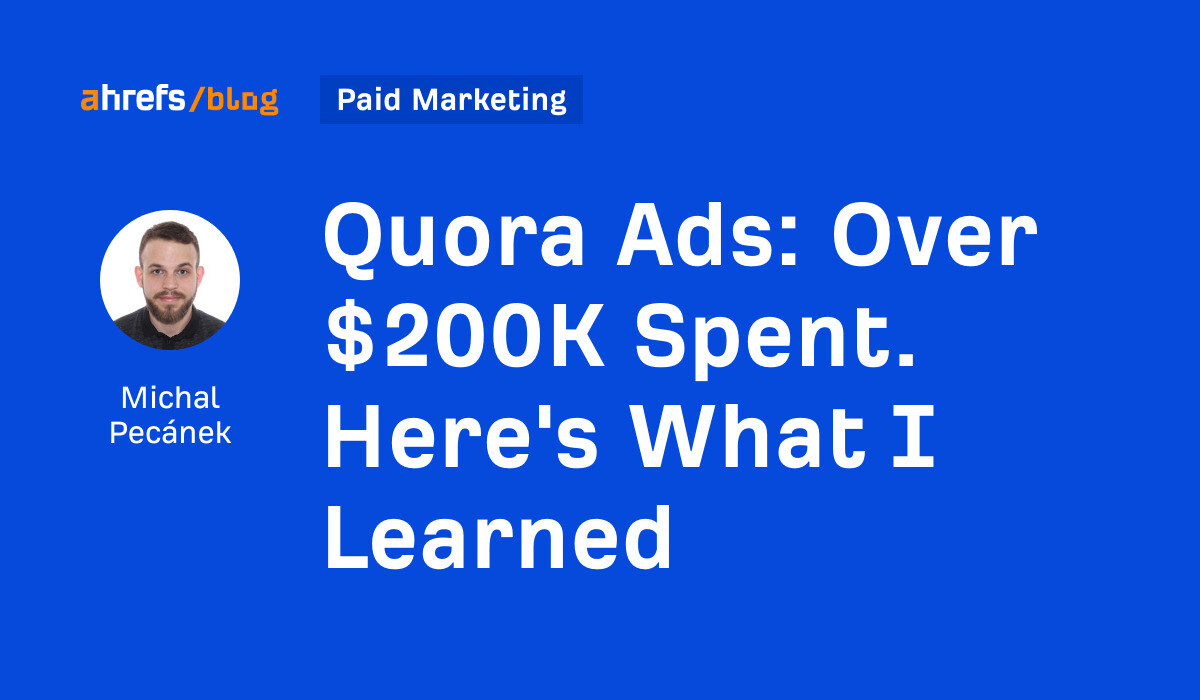
While it’s relatively easy to learn advertising on Quora, it takes a lot of trial and error to find out what works best. A few tricks can make your work more efficient and your campaigns more effective.
I’ve been using Quora Ads since it began in 2017, spent over $200K advertising for three global brands, and given lectures on how to succeed in it. I’ve managed campaigns on Facebook and Twitter too, so I have a fair comparison of what makes Quora Ads good or bad.
We’ll go through eight valuable Quora Ads takeaways that will save you tens of thousands of dollars in both ad spend and work hours.
Let’s dive in.
The days of super cheap clicks and impressions on Quora are long gone, but it can still be significantly cheaper compared to mainstream platforms like Google, Facebook, or Twitter.
I disclosed some data with the Quora team via a success story and a podcast episode based on my experience from previous employment. I was comparing this to search and display campaigns in Google Ads because the intent of Quora users isn’t far from that.
So back then on Quora Ads, we had:
- 65% lower CPC than comparable Google search campaigns.
- 46% lower CPA than comparable Google search campaigns.
As of now in Ahrefs, I can share the following numbers for comparable campaigns, which are:
- 40–50% cheaper CPC than Facebook.
- 60–95% cheaper CPC than Google’s search campaigns (yes, the difference can be that huge).
These are the cases where Quora is significantly cheaper than other main advertising platforms.
Quora has more expensive CPCs and CPMs (2–6 times) than Google Display Network campaigns, but it still seems like a great deal considering the intent and engagement of Quora visitors. More on this later.
Two main factors that determine how to best structure campaigns on Quora are budget and bid settings. The unfortunate thing is that the budget is set at campaign level, while bidding comes at the ad set level.
Here’s a problem that you can easily run into because of this:
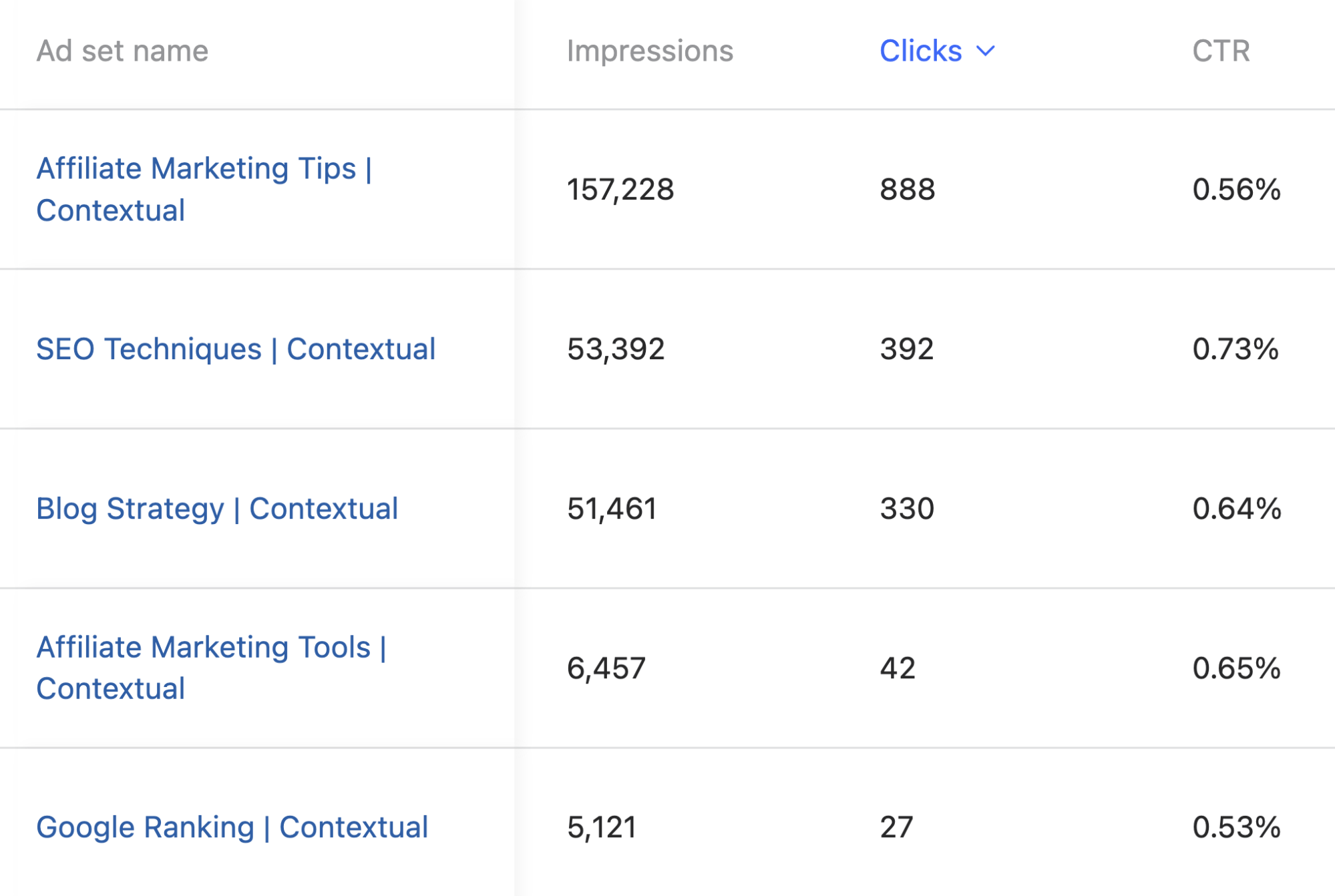
All ad sets were running side by side, with each having an estimated potential reach in the lower millions weekly. As you can see, the CTR of the most pushed ad set isn’t the highest, so engagement signals don’t play a huge role in Quora’s delivery algorithm.
It’s the bid size that makes the biggest difference.
Based on my experience, Quora’s delivery algorithms heavily favor ad sets with higher bids. Running multiple ad sets within one campaign becomes a challenge to optimize the ad delivery.
One solution is to bid the same across all running ad sets within one campaign. But that could create more problems if the targeting differs. It also doesn’t ensure balanced delivery.
I’ve always leaned toward the second solution: run just one ad set per campaign at a given time. It also has its downs, as you have to create and manage many campaigns at once. But it’s the best I could do. Here’s a sneak peek at Ahrefs’ blog promotion campaigns structure:

As you can see, I grouped campaigns by their geo-targeting and device type. This is the only structure that allowed me to properly manage the campaign budget allocation and ad distribution.
I generally recommend creating a separate campaign for each country and device. But I bundled together four countries to make the account easier to manage. The reasons for this were similar CPCs across all those grouped countries, confirming that impressions were being distributed proportionally to each country’s population.
PRO TIP
Fortunately, my Quora account managers were always helpful and dug into such data for me. It’s worth trying to get in touch with them should you ever need data you can’t get yourself.
Quora Ads offers four different types of primary targeting:
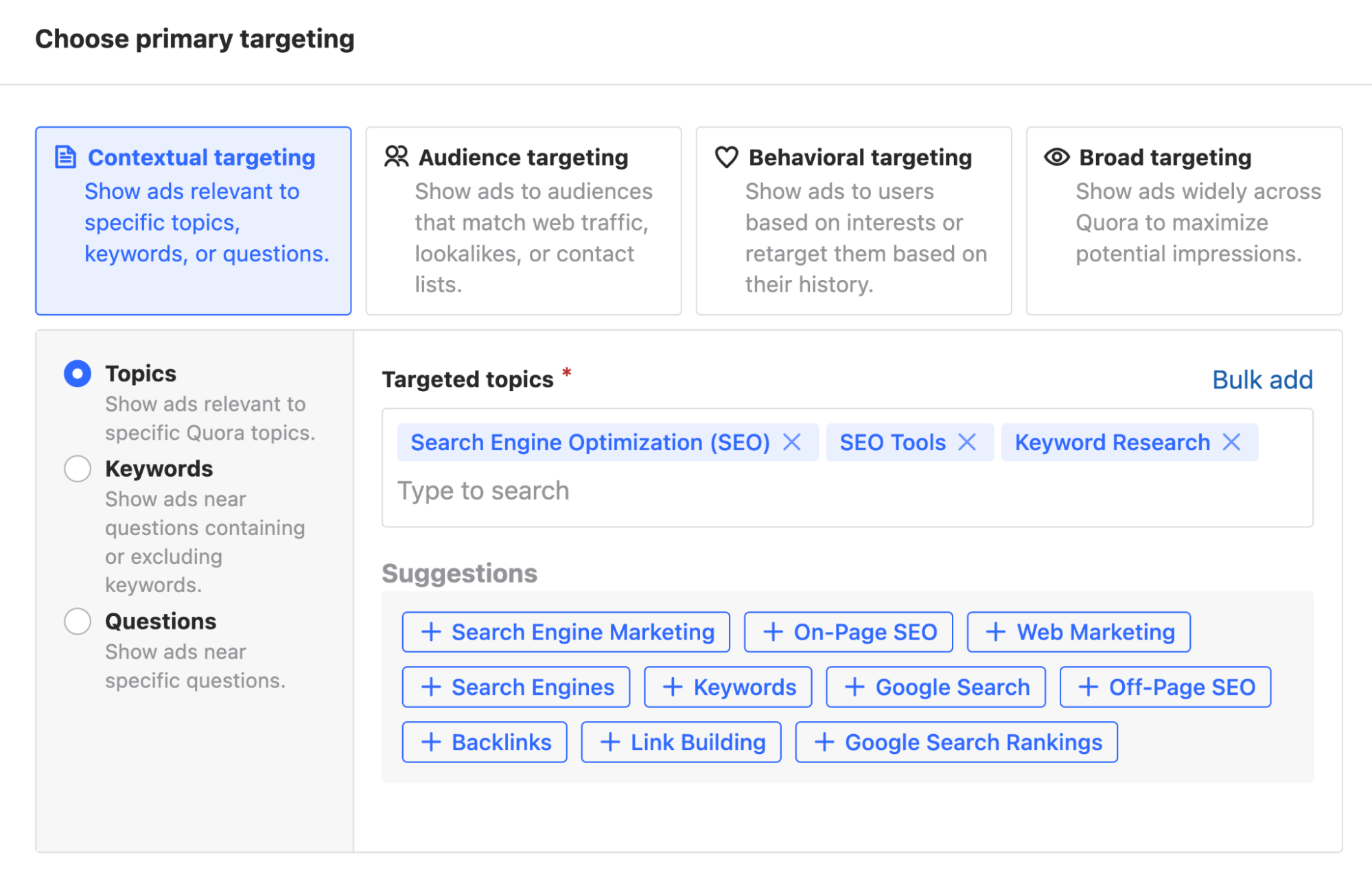
Audience targeting and broad targeting are things we can encounter on other platforms too. Nothing too groundbreaking there, so let’s focus on the other two primary targeting types: contextual and behavioral targeting.
You can read what it’s about in the screenshots, so let me jump straight to the best use cases.
In Ahrefs, I most often went for the Contextual -> Topics targeting shown above. It gives us solid control over where the ads are shown. But it pays off to learn how Quora assigns topics to its questions, as that’s far from perfect.
To do this, look up the topic in the search bar and go through the results:
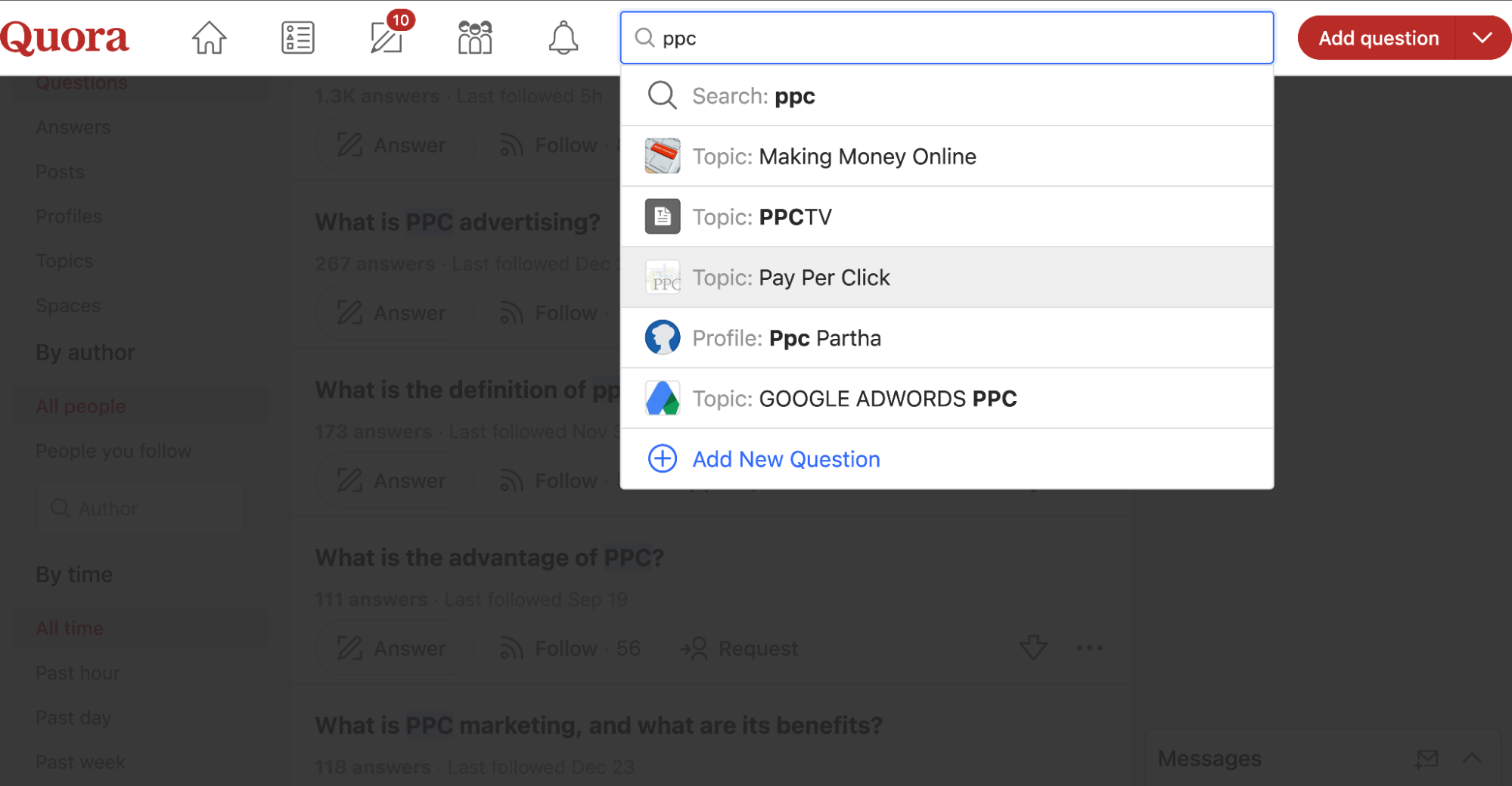
Switch to the “Answer” tab to only see questions, then check the list and inspect all the labels under a few questions after clicking “View question log” to better understand how good or bad of a job Quora does in your niche:
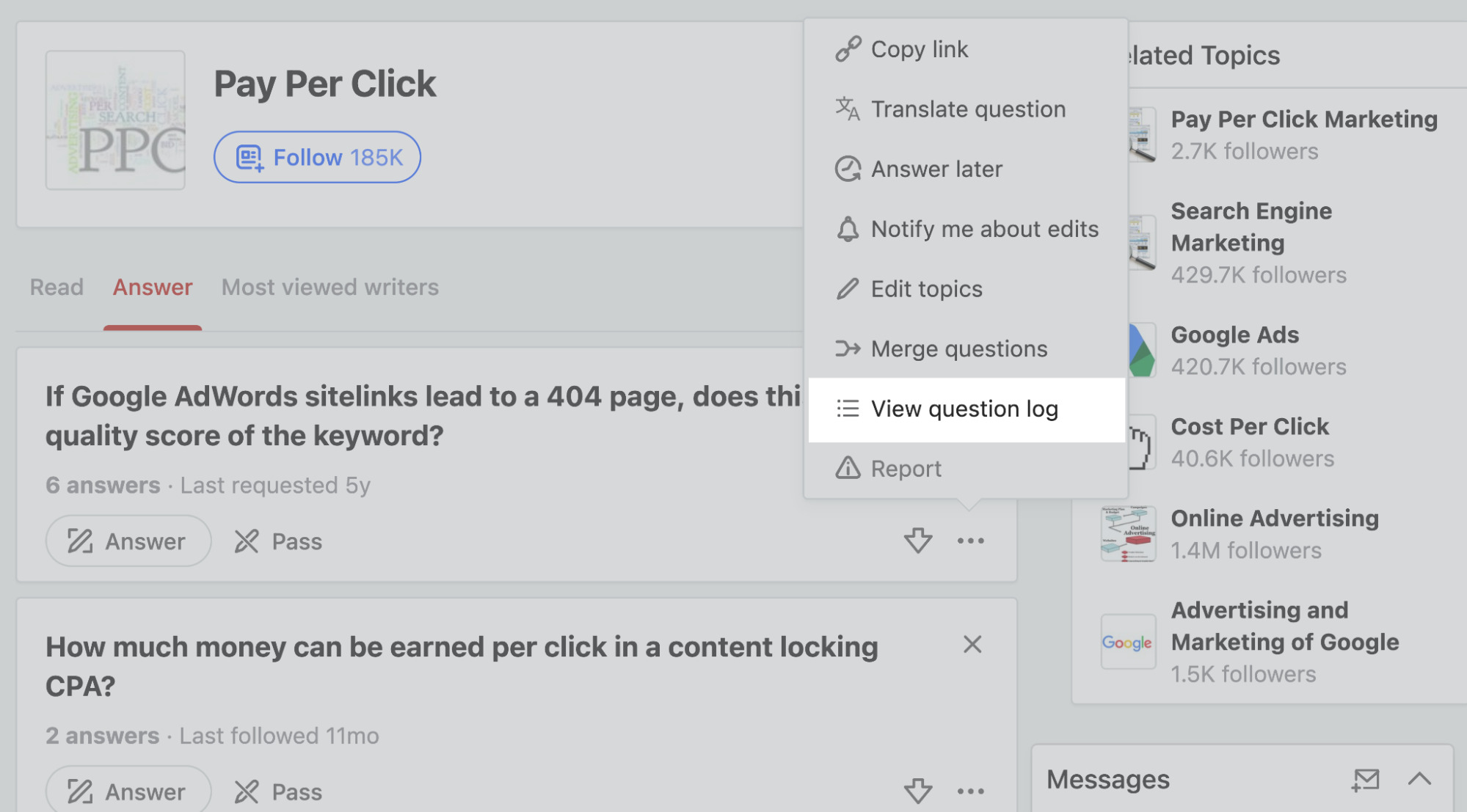
Here’s an example of how broad or irrelevant Quora can go sometimes:

However, in my experience, going a bit more broad with the choice of topics usually performed better than trying to be very specific.
Then we have Behavioral -> Interests targeting:

This type of targeting resembles what we’re used to from Facebook or Google. Quora models the interests of each user and then tries to show them relevant ads.
You get a higher potential reach at the cost of relying on a black box. That generally results in lower engagement but also in lower CPCs since the much more relevant contextual targeting comes with a slightly higher price.
Now that you’re more familiar with the primary targeting types, we can visualize the competitive advantage of Quora Ads:

Both Topics and Interests sub-targeting types are the broadest ones in each category. This is desirable for the purpose of most Ahrefs campaigns.
But my previous company needed much more granular targeting.
The possibility to target each Question (technically individual Quora URLs) was at the top of our targeting arsenal.
Choosing specific questions to bid on with your ads may be the biggest advantage of Quora Ads. You can show your ads to Quora visitors who are thinking about problems your product can solve at that exact moment as they read answers to that question.
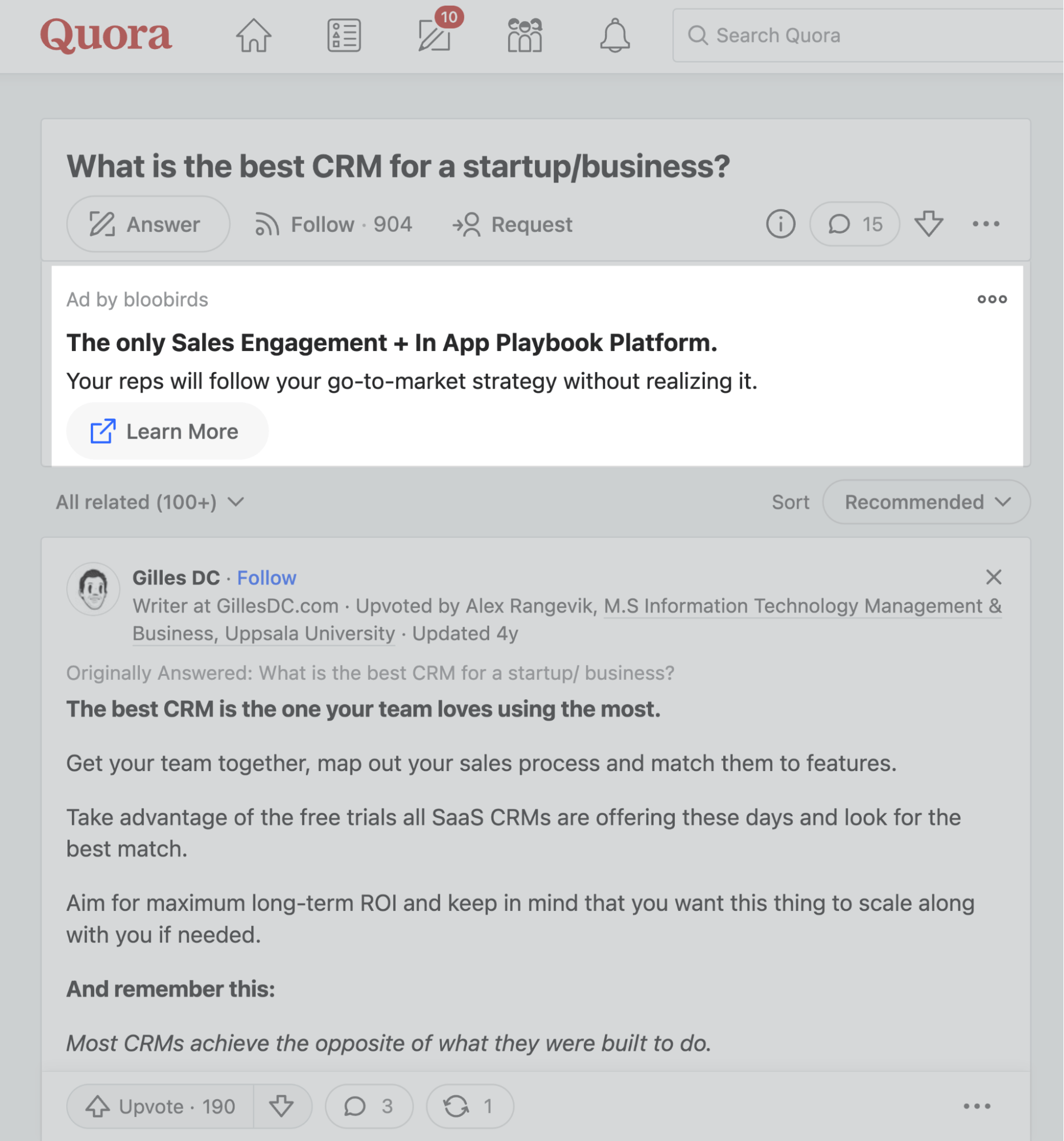
You also have complete control over the ad placement, which comes in handy when all the topic labels are too broad for your needs.
But how do we find the right questions to target?
Given that Quora drives an estimated ~114M non-branded clicks from organic search a month, it only makes sense to incorporate some SEO processes into this questions mining task.

There are multiple paths to getting an exhaustive list of Quora question URLs. I’d recommend starting with the most efficient one: using Quora’s own questions suggestion feature after you click on “Bulk add” here:
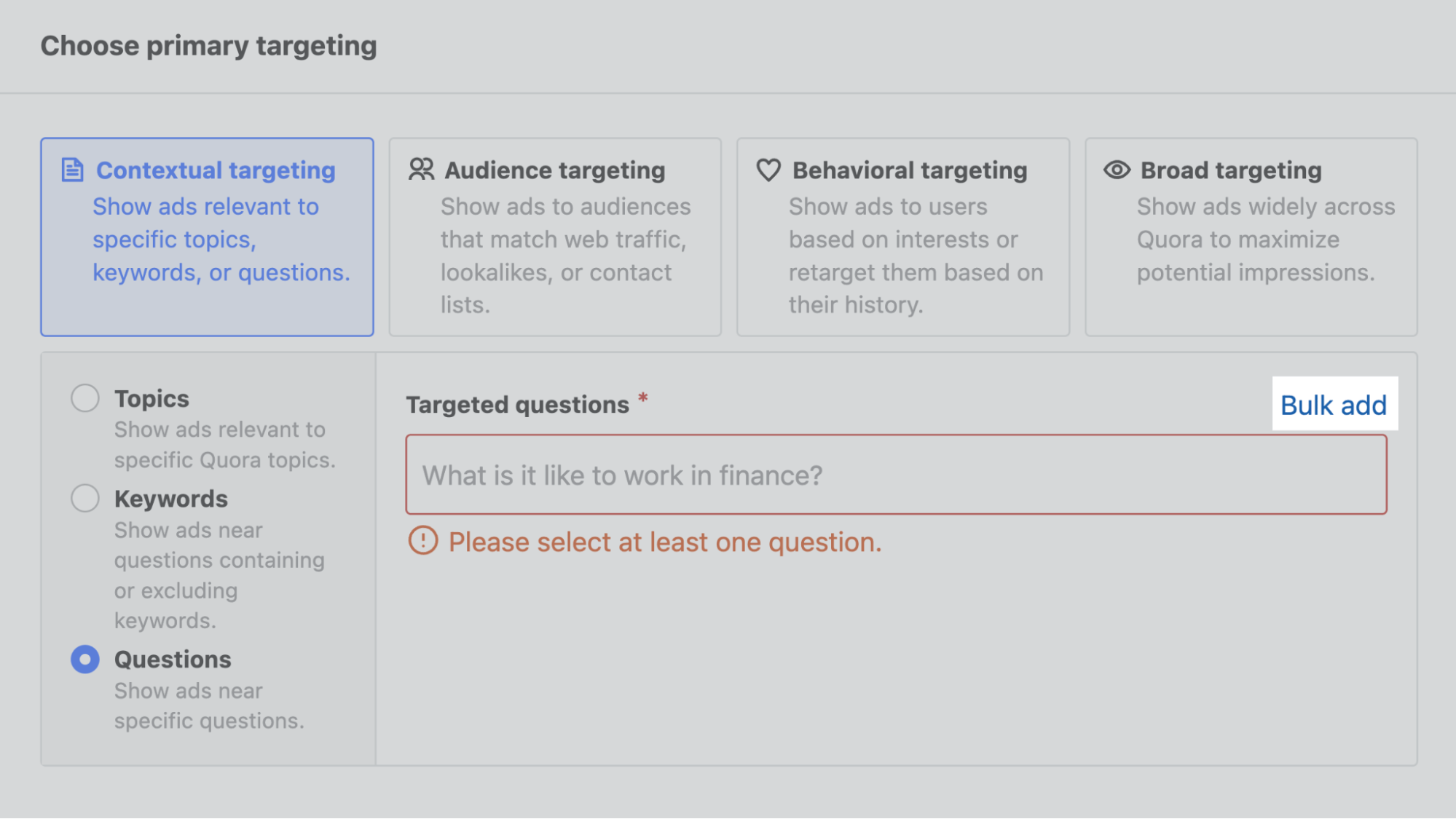
Then write down at least 10 keywords that best describe your business, products, or problems your audience is trying to solve. The more, the better. Add your competitor brands and products too. If you’ve already done some keyword research for SEO in the past, then this is a piece of cake.
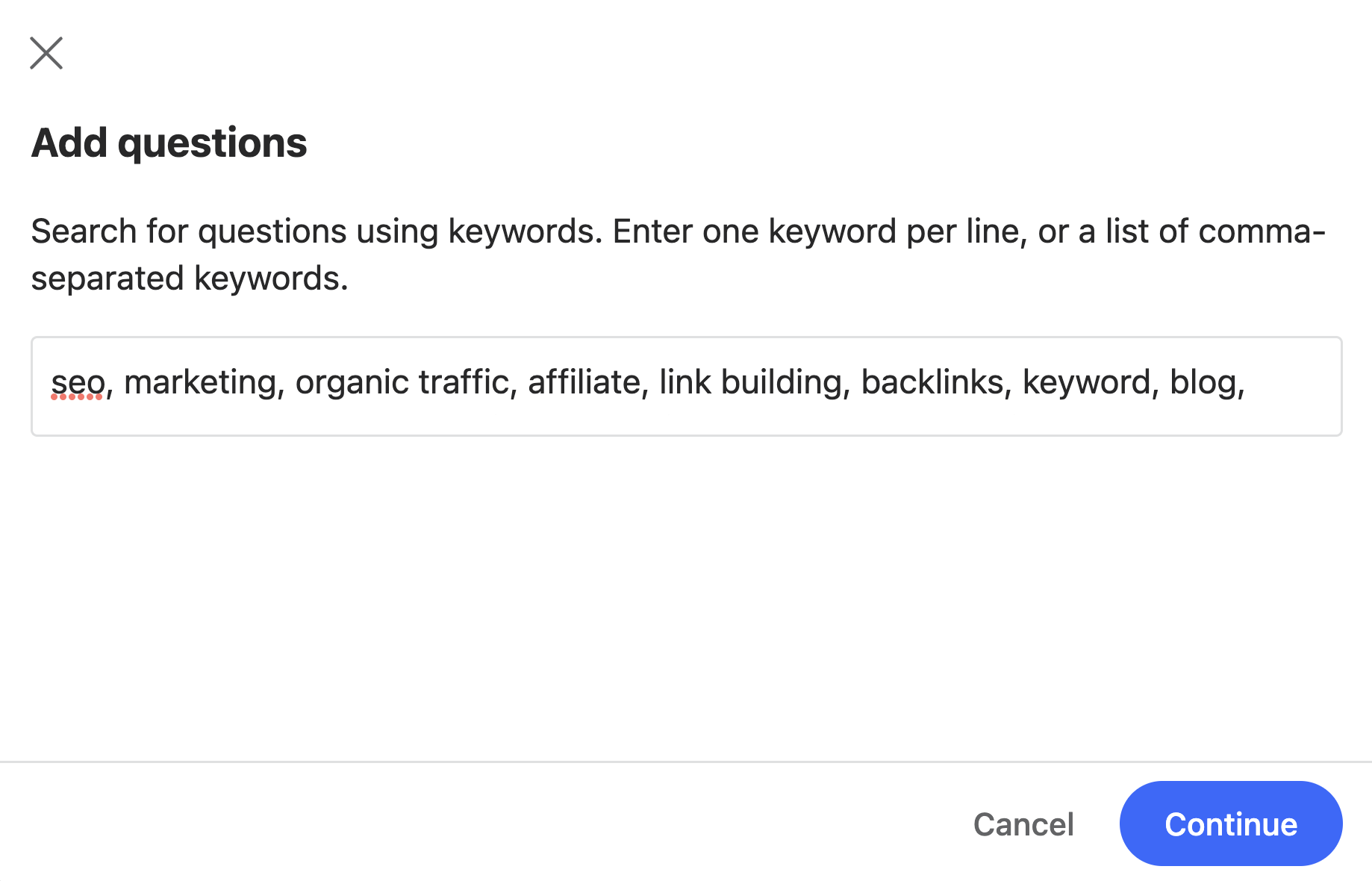
You’ll get a list of questions sorted by weekly views. As you can see in the list below, the matching isn’t perfect, as it shows “stock market” questions based on my “marketing” keyword input. On the other hand, you don’t need to worry about including exact match keywords.
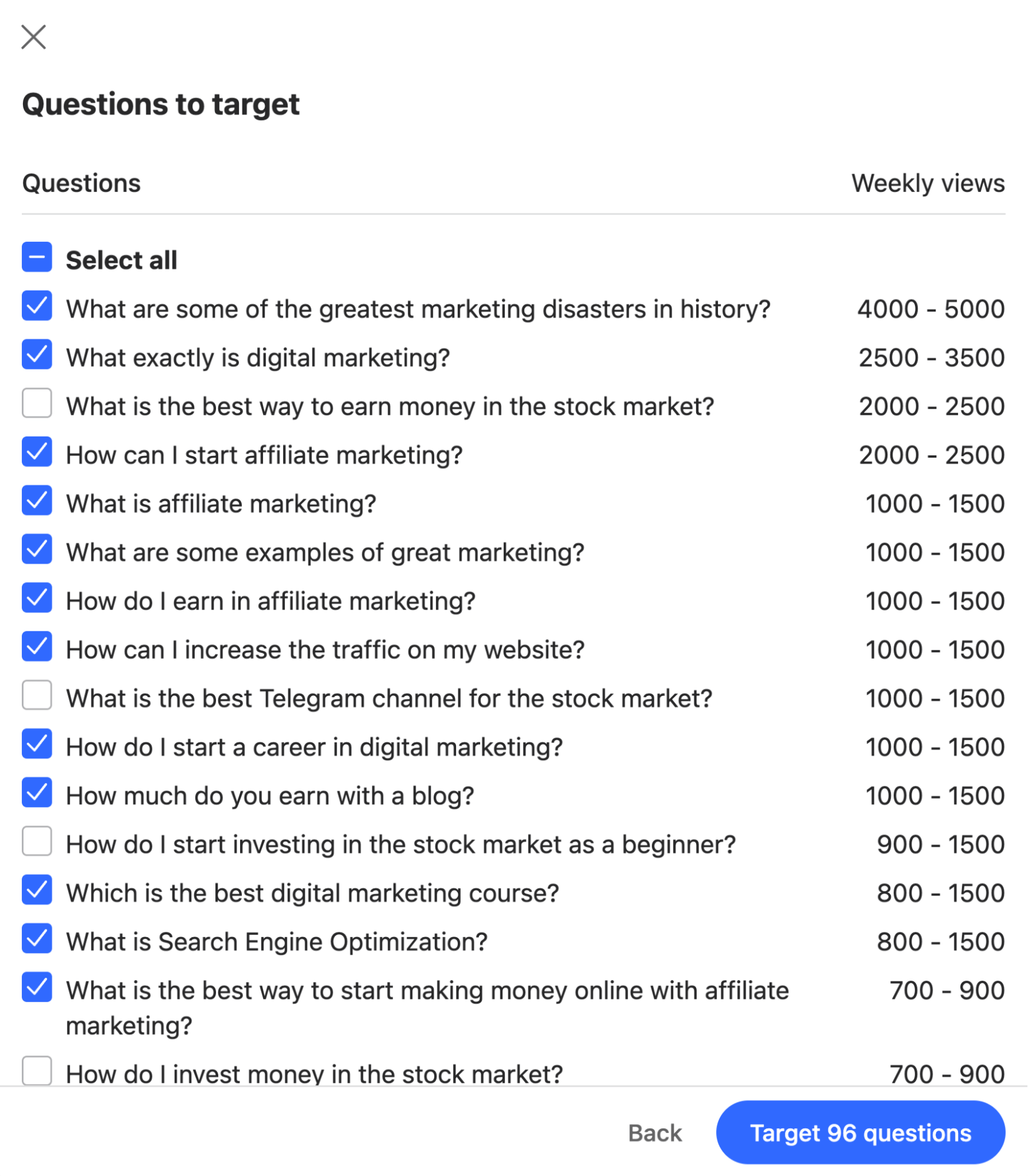
You can select the most relevant questions to target and end the questions research here. But I like to take this one step further and gather organic traffic data for each question. It helps with question prioritization that we’ll discuss in the next point.
So while you’re in the “Questions to target” window, open up Ahrefs’ SEO Toolbar and head over to “Outgoing links” since all the questions in the list are linked through.
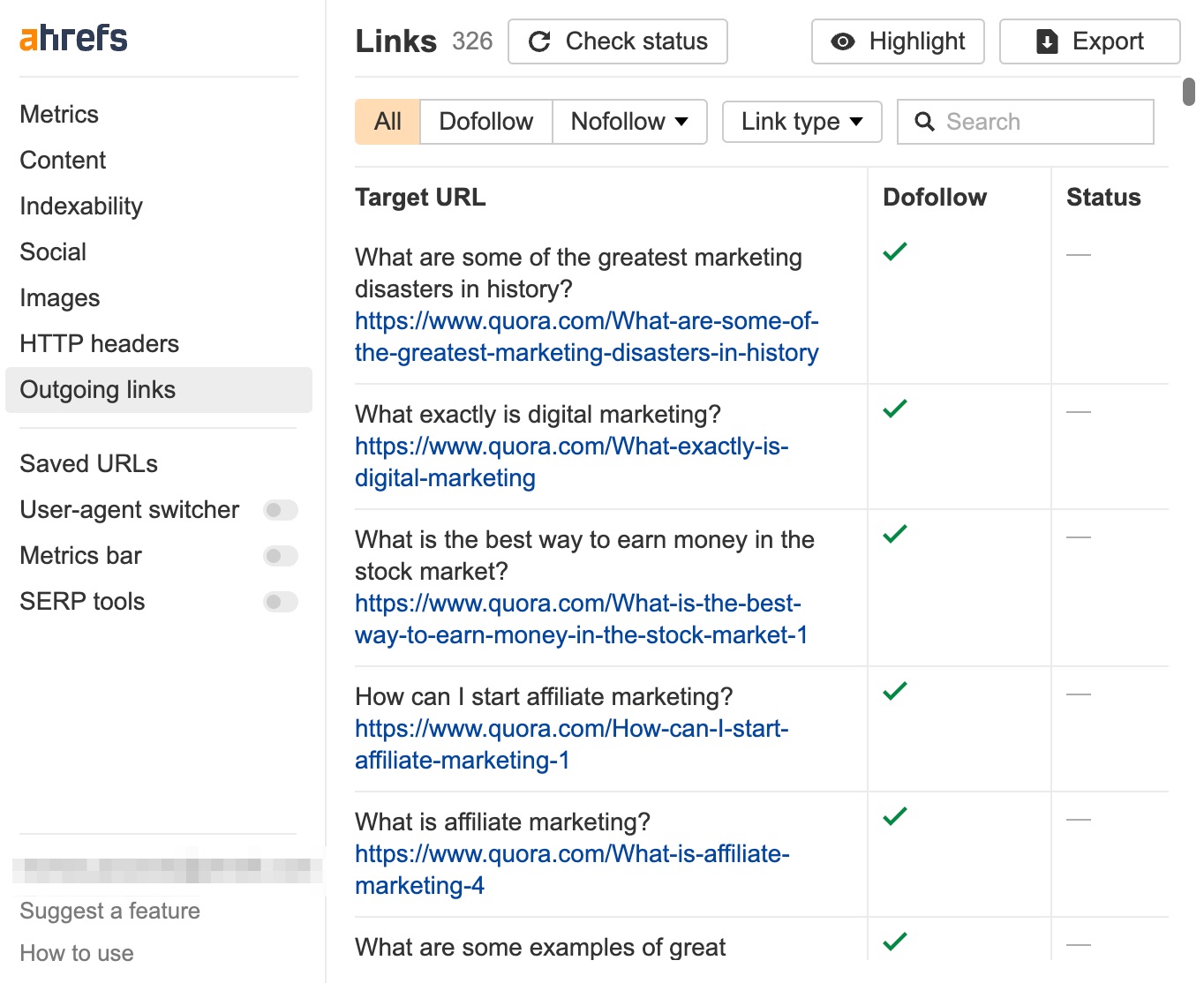
Click on the export button, and you’ll get a list of all the URLs there. All that’s left is to filter the list for relevant questions, copy-paste it into Ahrefs’ Batch Analysis tool, and sort the table by organic traffic:

There you have it—organic traffic estimations on top of Quora’s traffic data. I’ll always prioritize questions that get solid organic traffic over what’s currently trending on Quora, as Google tends to be a more sustainable traffic source.
You can now run highly relevant and engaging campaigns, including those that retarget Quora users based on questions they visited in the past. Just copy-paste the input window between Contextual – Questions and Behavioral – Question history.
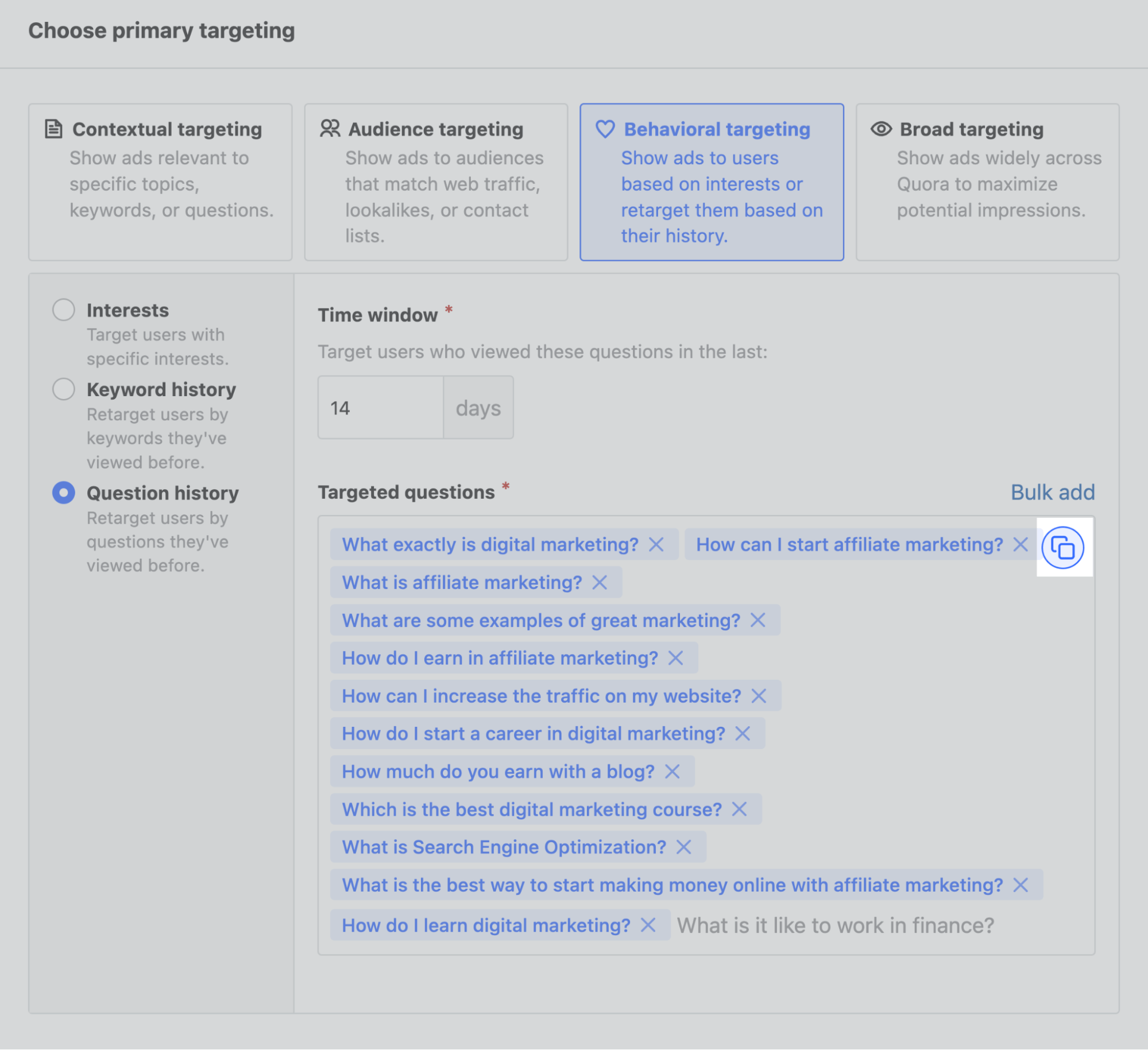
Organic growth on Quora isn’t easy. But still without putting in too much effort, some of my answers got tens, even hundreds of thousands of views and rank among the top answers:

OK, I cheated a bit. The easiest way to get such numbers is to simply boost your answers with Quora Ads. It provides a unique ad format called Promoted Answers:

Just feed the system with any answer URL, and it will show the answer as an ad throughout the platform based on your targeting:
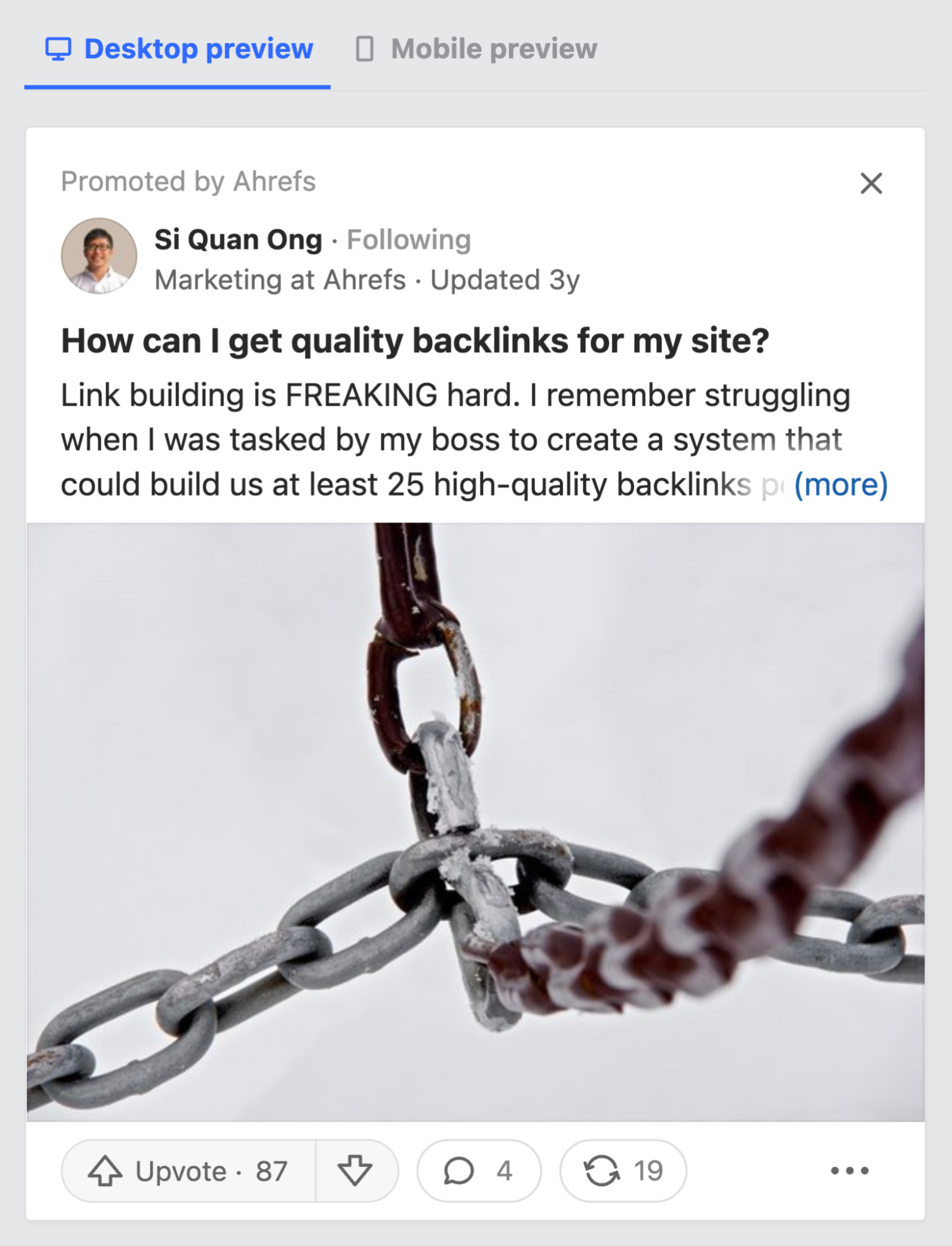
The best thing about this is the ability to promote any answer. And since we just went through sourcing a list of the most relevant Quora questions, we can leverage it here too. Just go through the answers in the most promising questions and note all answer URLs that positively mention your brand or product.
If you decide to skip the Questions targeting, you can also do a simple search in Google using search operators to filter Quora URLs that mention your brand or product:
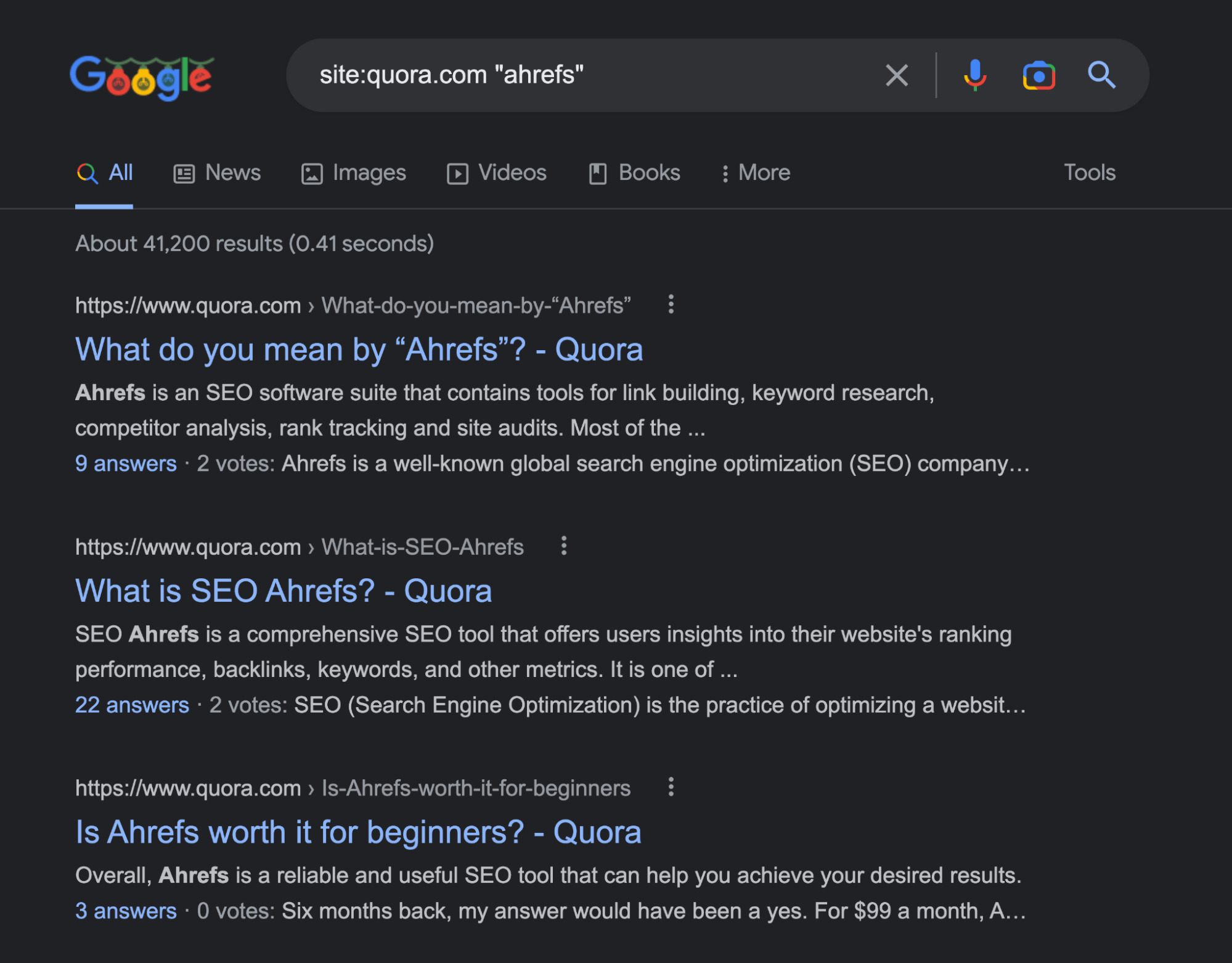
I haven’t run these Promoted Answers in a while. But back then, I was getting a cheap CPM at around $1. It seemed to work well for brand awareness campaigns. I’m also convinced that it has an influence on how Quora ranks the answers for a certain question, as you get much more views and upvotes compared to the rest.
To sum it up: Quora is no different than other platforms, and you get the best results if you properly combine both organic and paid marketing. Promoted Answers are an interesting ad format worth experimenting with for increasing brand awareness.
You can learn more about succeeding with your organic efforts in a guide by my colleague, SQ, who took over marketing topics on Quora by storm a few years ago.
One of the earlier points is about Quora Ads being cheaper than other platforms. This, of course, depends on how well managed and optimized your campaigns are because, sometimes, the suggested CPCs are anything but cheap:

First of all, besides brand awareness campaigns, I always go for bidding on the CPC basis. I found it cheaper than bidding on CPM. Also, I have no data about CPA bids, as we don’t use tracking pixels in Ahrefs.
In terms of CPCs, I usually stick to the lower range of the suggested bid. I then readjust the bids based on the impression share it gets. My rule of thumb is keeping the impression share between 10% and 30%, which I found to be the best balance between solid ad delivery and reasonable prices.
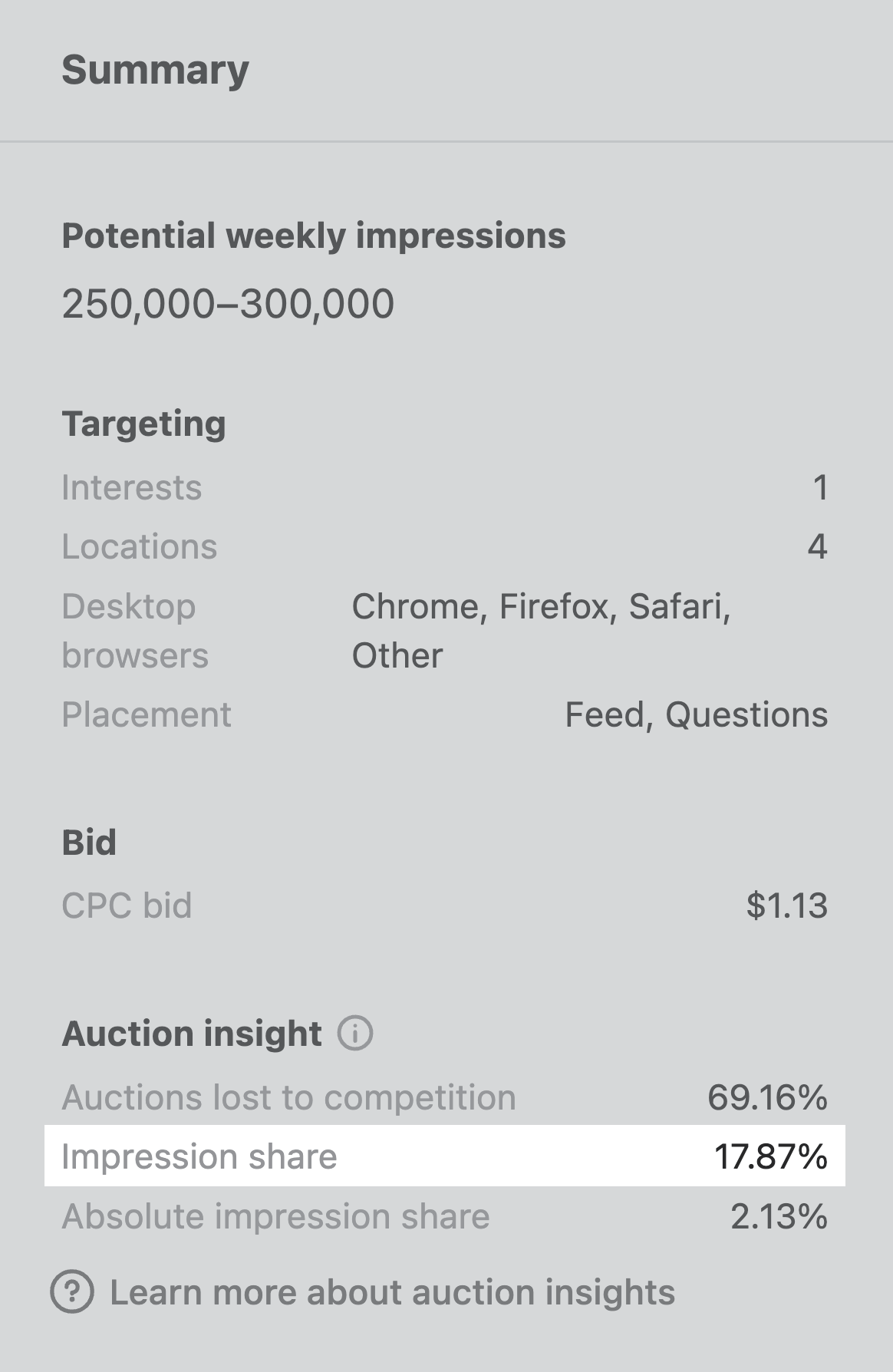
I still kept some of my more expensive ad sets below 10% impression share if they easily managed to spend the daily budget, thanks to broader targeting and reach.
Speaking of reach, I found Quora to sometimes report weirdly overestimated potential weekly impressions:

I wrote down a specific case where it kept showing 3,500–15,000 potential weekly impressions in an ad set that only received 400 impressions with 12.5% impression share over six months. It fixed the reach estimation in this case already, so I’m only left with a written note and no screenshot.
But considering we can trust the numbers in most cases, let’s do some quick math with relevant numbers based on Ahrefs’ advertising on Quora.
A campaign with a $50 daily budget and an average CPM of $2.5 will spend the budget after 20,000 daily impressions. That equals 140,000 impressions weekly. A 15% impression share means that our running ad set(s) will need to have potential weekly impressions of at least ~930K, let’s say a million.
That said, Quora claims 300 million+ monthly visitors, but it’s sometimes rather difficult to put together targeting that results in a big enough estimated potential reach. At least in our SEO and marketing niche.
All in all, the vast majority of ad sets I ran recently had a weekly potential reach between 500K and 10M. Otherwise, I wouldn’t be able to achieve the desired performance. You can easily run into a situation where you need to decide what makes the most sense for you:
- Increase bids for higher impression shares
- Broaden targeting for higher reach at the cost of a potentially lower ad relevance
- Keep your campaigns hitting the ceiling and allocate the rest of the budget elsewhere
And this is just the beginning when it comes to scaling up your campaigns.
As explained earlier, the best structured account for optimal ad delivery and effectiveness comes at the cost of being more difficult to manage. Creating new ad sets and running new ads involve a lot of clicking around. There’s no duplicating and controlling ad sets at scale. You have to do them one by one.
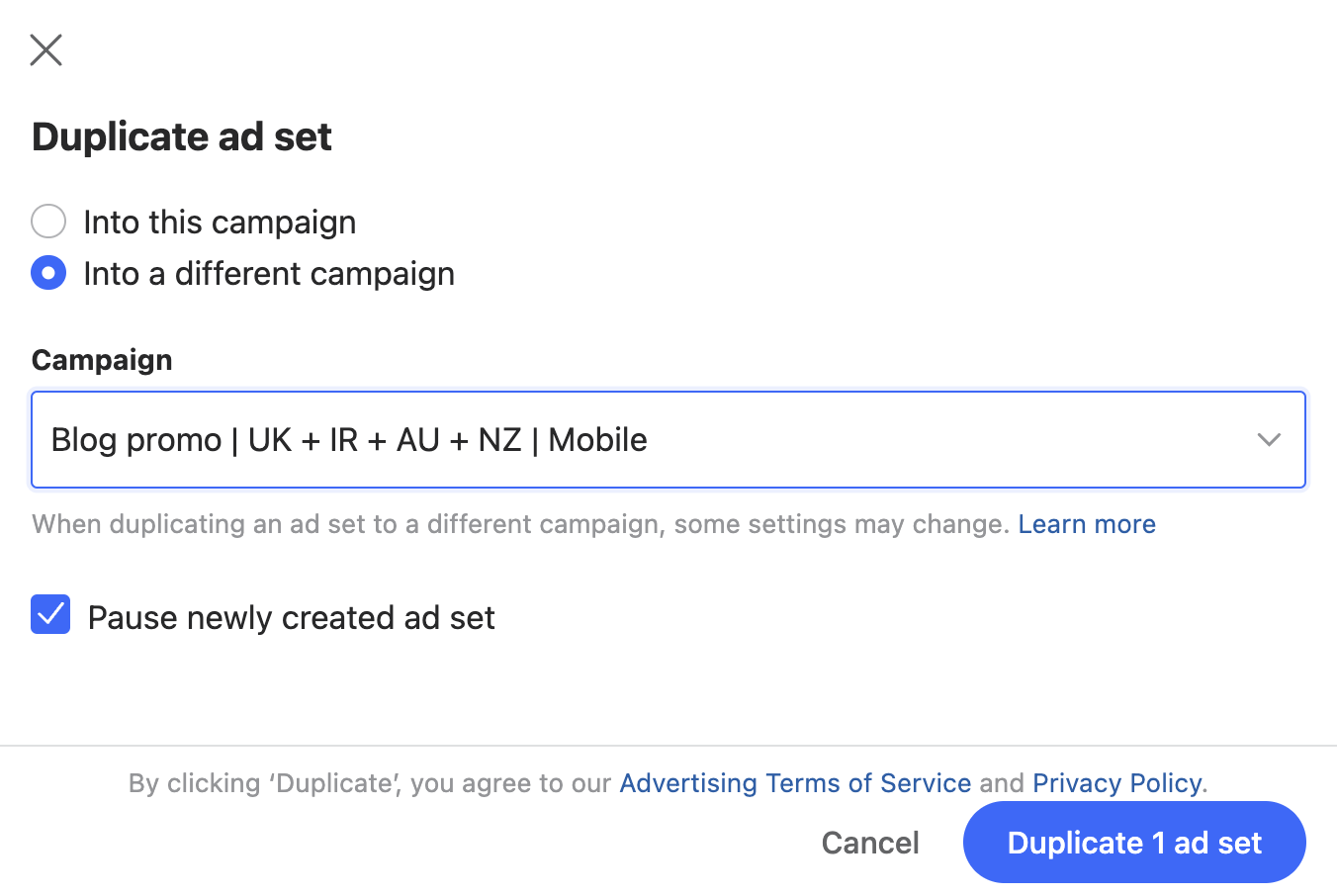
Once you get the hang of it, it takes a matter of a few minutes. But it’s still annoying.
Should you only require duplicating, uploading, or editing ads in multiple ad sets at once, then Quora’s ad editor comes in handy.
When I brought this inconvenience up with my account managers, they told me that my approach seemed to be the most efficient indeed. A good thing is that they offered help managing the campaigns if the clicking around ever became too bothersome.
So while account management and scalability in Quora Ads are far from perfect, it at least partially compensates for that with the best customer service I’ve encountered with any advertising platform.
Final thoughts
I’m not a PPC specialist, just a marketer that took the opportunity to learn to run Quora Ads and a few other advertising platforms on the go. I strived to describe only the most important and interesting takeaways that could take a while for even experienced PPC specialists to figure out.
Other than this, there are more similarities to other PPC platforms than differences. That’s why I didn’t even bring up creating ads, for example—there’s nothing special about this on Quora.
So are you going to give it a shot? Do you have any questions? Ping me on Twitter.

















You must be logged in to post a comment Login